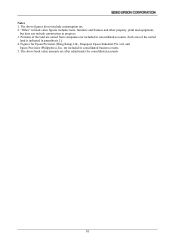Epson 2012 Annual Report Download - page 21
Download and view the complete annual report
Please find page 21 of the 2012 Epson annual report below. You can navigate through the pages in the report by either clicking on the pages listed below, or by using the keyword search tool below to find specific information within the annual report.
20
Business Conditions
1. Overview of business result
(1) Operating results
The global economy continued to grow at a slow pace throughout the year under review, with mounting
uncertainty over the financial futures of some E.U. member states and soaring crude oil prices contributing to the
slowdown. The economic picture varied by region. In the U.S. economic growth was slowed by factors such as
continued high unemployment. In Europe, the economy was seen picking up in the first half, but it later stalled
under the weight of continued high unemployment rates and rising uncertainty about the financial futures of
several European countries. China and India recorded growth, mainly due to internal demand. As a whole, the
other countries of Asia also headed toward recovery. Japan, meanwhile, continued to struggled in the aftermath
of the March 11, 2011, earthquake and tsunami, but the economy began to gradually pick up in the second half
as government economic measures took effect.
The situation in the main markets of the Epson Group (“Epson”) was as follows.
Demand for consumer inkjet printers was weak due to soft markets, especially in Europe and North America.
Business inkjet printer demand picked up in China and other parts of Asia experiencing economic growth but
was moderated somewhat by spending restraints in the printing industry and other sectors due to economic
uncertainty. While the serial dot-matrix printer (SIDM) market is contracting in America, Europe, and Japan,
demand remained firm in some regions, including China, Southeast Asia, and South Asia. In POS systems,
capital expenditure by retailers showed signs of a picking up in China and Singapore, but U.S. retailers remained
reluctant to invest. In projectors, sales of models for the education market were firm in China but soft in North
America, Europe, and Japan due to factors such as education budget cuts.
Demand for the main electronic device applications generally remained steady across the period.
New mobile phone demand, buoyed by demand in emerging markets such as India and China, was firm during
the first half of the year but showed signs of weakening in the second half. Meanwhile, a dizzying array of new
smartphones with faster transmission speeds provided traction for the upgrade market. The digital camera market
remained firm, with sales of SLR models particularly solid, while the tablet PC market also expanded. On the
other hand, the television and PC markets were generally weak in the advanced economies. Meanwhile, the
market for portable media players trended downward as the first round of demand wound down and as the
number of mobile phones with music player features increased.
In the precision products market, watch demand rebounded in America, Japan, and other parts of Asia but
showed signs of softening in Europe. Robot demand also increased in tandem with the rise in demand for
automobiles in overseas markets.
Epson has been taking action to restore profitability and rebuild the company's business foundations under the
first of two three-year business plans designed to achieve the SE15 Long-Range Corporate Vision of becoming a
community of robust businesses. In Fiscal 2011, the final year of the first three-year plan, Epson's performance
was affected the European financial crisis, the sustained strength of the yen, and a series of devastating natural
disasters. Epson responded to these challenges while carrying out the core strategies in the plan. Steady progress
in implementing these strategies enabled Epson to expand its business domains and product lineups, as well as to
reduce its total costs for a dramatically improved cost structure, thereby putting the company back on a path to
growth.
Extraordinary losses recorded for the 2011 fiscal year include a ¥6,052 million payment to settle a lawsuit
involving allegations of involvement in an liquid crystal display price-fixing cartel, a ¥2,125 million
extraordinary loss on disaster associated with charges in the aftermath of the northeastern Japan earthquake and
tsunami, and a ¥2,024 million loss incurred on the transfer of a subsidiary company when the small- and
medium-sized displays business was transferred.
The average exchange rates of the yen against the U.S. dollar and of the yen against the euro during the year
under review were ¥79.08 and ¥108.98, respectively. This represents an 8% appreciation in the value of the yen
against the dollar and a 4% appreciation in the value of the yen against the euro, year-over-year.
























